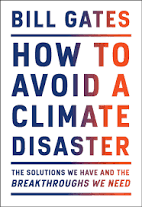In his new book, How to Avoid a Climate Disaster, a man who has left his mark on software, business, and philanthropy sets his sights squarely on the world’s  greatest crisis: climate change. In doing so, Bill Gates provides a credible and comprehensive overview of what must be done for a chance of avoiding the most catastrophic effects of what he describes as the greatest challenge humanity is facing – the same way we describe the challenge at RMI. As an author on this, he is both deeply passionate and very well-informed, and elevates the importance of the topic to a wider global audience in a very understandable book. It is a worthwhile read!
greatest crisis: climate change. In doing so, Bill Gates provides a credible and comprehensive overview of what must be done for a chance of avoiding the most catastrophic effects of what he describes as the greatest challenge humanity is facing – the same way we describe the challenge at RMI. As an author on this, he is both deeply passionate and very well-informed, and elevates the importance of the topic to a wider global audience in a very understandable book. It is a worthwhile read!
Like us at RMI, Gates is a technologist who recognizes the crucial differences between energy and IT, particularly with regard to how pathways differ for innovation and deployment of solutions in each sector. In one of my favorite quotes towards the beginning of the book, he writes: “Even I can recognize that you have to be a pretty big nerd to write a sentence like ‘I’m in awe of physical infrastructure.’” So are we!
At RMI we always talk about the complex nature of the energy system. This book accurately reflects how the energy transition is much more complex than only decarbonizing the power system and deploying electric vehicles. Gates provides a simple taxonomy of the entire energy system in an easily understandable table at the beginning of the third chapter. This taxonomy includes not just plugging electric devices into the power grid, but also making things, growing things, getting around, and keeping warm or cool.